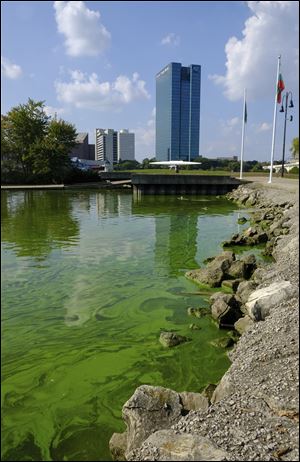
Lake Erie rescue plan needs teeth
3/14/2018
An algae bloom from Lake Erie appears in the boat basin at International Park.
Ohio environmental officials have said for years that voluntary measures to cleanup Lake Erie pollution will be sufficient to save the lake. A lack of any real progress on lake pollution has proven them wrong.
This makes a new federal plan for the lake cleanup a real disappointment because it likewise relies on voluntary measures rather than real accountability.
Click here to view more Blade editorials | Check out the Behind The Editorial series
The federal Environmental Protection Agency’s recently released action plan for the lake calls for a 40-percent reduction in the amount of phosphorus pollution by 2025. This would be a good plan if there were any chance of hitting that 40-percent reduction goal.
Ohio authorities agreed to the same benchmark in 2015 and yet the region is not nearly on pace to hit it because the state has insisted that simply urging agriculture and other polluting industries to reduce the amount of algae-producing nutrients they allow to run off into the lake and its tributaries will be enough.
The U.S. EPA’s plan calls for the strategies that experts agree will work — more careful and targeted uses of fertilizer that minimize runoff into streams and rivers, use of cover crops to remove phosphorus from the soil, and the use of filtering systems and field tile to reduce runoff into waterways.
What it unfortunately does not include are the mandates to track and quantify the sources of pollution now flowing into Lake Erie and feeding toxic algae blooms each summer. The plan also does not include the legal measures to hold polluters accountable if they exceed pollution limits.
In previous cases such as the cleanup of Chesapeake Bay, real progress toward clean water required real enforcement of hard limits. The cleanup of Lake Erie will require nothing less. If good will and encouragement were enough to reduce the water pollution, then surely we would have seen better progress in the last three years than we have.
Annual algae blooms that coat the lake in sickly green goo each summer threaten the Toledo area’s drinking water supply, economic development, and quality of life.
A federal court judge is expected to rule soon on a lawsuit from activists seeking to force the state and federal governments to apply the Clean Water Act to Lake Erie’s current dire situation, bringing the force of law and meaningful enforcement to cleanup standards.
The lack of any real progress toward reduced pollution and a cleaner, safer Lake Erie in the nearly four years since toxic algae rendered the city’s water supply unusable for three days in 2014 is evidence that serious enforcement is necessary.
A toothless plan is no kind of plan to cleanup Lake Erie. That sort of plan is just a waste of time and Lake Erie does not have time to spare.
Follow @BladeOpinion on Twitter.